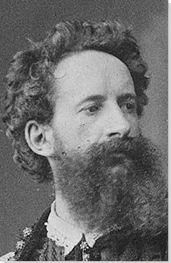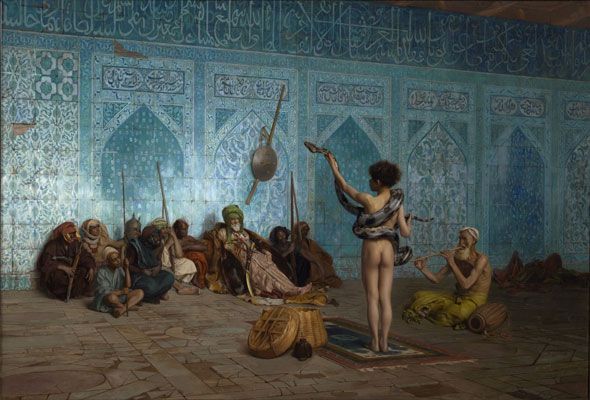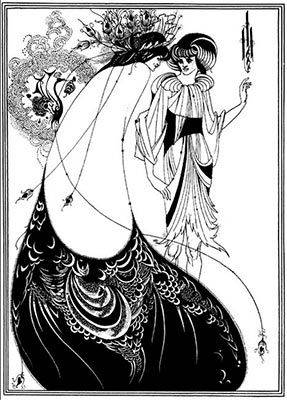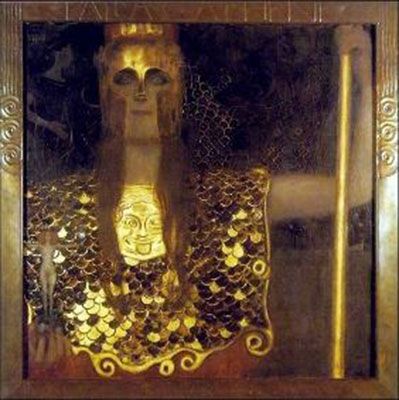Summary of Hans Makart
Both celebrated and condemned for his sensual, historical and legacy paintings, Hans Makart produced richly colored and atmospheric works that had an extraordinary impact on late-nineteenth century Viennese culture. Markart was so popular, in fact, that he gave his name to the so-called Makartstil - or Makart-Style - a virtual school of art and design that helped decorate many of the public places in Vienna in the second half of the nineteenth century. Makart's art was condemned however by academics who took exception to the artist's general lack of regard for factual accuracy and for denigrating important historical events by featuring gratuitous female nudity. In the public sphere, meanwhile, he was known as much for the outrageous society parties as for his art. His sumptuously decorated Venetian studio was where royalty, politicians, artists and writers came to mingle and to "be seen". Such was his celebrity in fact that he has be referred to by several commentators as the Andy Warhol of his day.
Accomplishments
- Makart's paintings were produced on a theatrical scale with a richness of color that he learnt from Peter Paul Rubens. Though sneered at by some "experts", the sheer scale and spectacle of his art made him seem to the public like a giant amongst contemporary Austrian and German artists.
- The artist carried his love of vivid color and unabashed ornamentation into the spheres of interior and fashion design. In many ways Makart's design preempted the Art Nouveau movement that came to prominence in the decades after his death. Indeed, Makart exercised a tremendous influence over Gustav Klimt, and by extension, his leadership in the Vienna Secession movement (the Austrian style of Art Nouveau).
- Makart is associated chiefly with the idea of Aestheticism, a philosophy initiated in Britain in the late nineteenth century by the likes of J. M. Whistler and Albert Moore. Aestheticism places style and decoration over any search for literal or factual truth. Makart's audacious use of color to heighten dramatic effect came to associated both with the aesthetic self-discipline of Neoclassicism and the aesthetic freedom of Romanticism.
- Makart's celebrity reached its apotheosis when he took charge of the design of the costumes, scenery and the carriages for the grand pageant in which the citizens of Vienna spilled onto the streets to celebrate the silver wedding of its Emperor Franz Joseph. Under Makart's direction, it is estimated that a total of some 15,000 people appeared bedecked in Rubens and Rembrandt period costumes.
The Life of Hans Makart
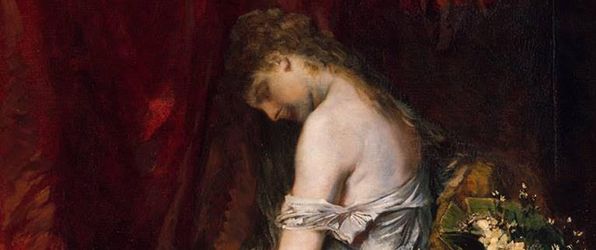
A master of networking and self-promotion, Hans Makart was better known and more acclaimed in his lifetime than his contemporaries Monet, Manet and Degas. But history has almost forgotten his sensual and sumptuous works, and he is most remembered for being an inspiration to Gustav Klimt.
Important Art by Hans Makart
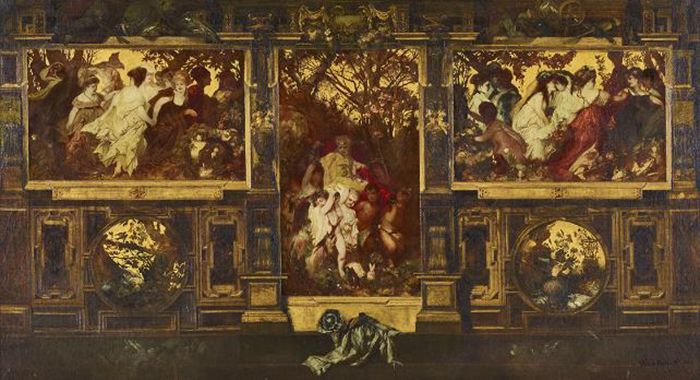
Moderne Amoretten (Modern Cupids)
The three canvasses that make up this work are here arranged as Makart himself stipulated. All three depict a woodland scene, populated by pale-skinned women. Clutching one another, they are clad in loose, flowing drapery which appears to evoke a scandalously revealing version of contemporary fashions. In the central canvas, a woman crowned with flowers and two others are borne up by four young children, two cupids and two fauns.
By using gold rather than blue sky as the background to this painting, Makart overwhelms the spectator with an opulence that is continued in the tumble of foliage and cascade of sumptuous fabrics. The only respite from this ornamental suffocation is the cool whiteness of the figures' bodies which provide a "breath of fresh air" over any cloying eroticism. Makart's technique is reminiscent of Medieval and early Renaissance painting, a key source of influence for Symbolism and Aestheticism. In the left image, the twisting women linking hands is strongly reminiscent of the archetype of the three graces, a classical trope that is counterbalanced by the modern dress. This dance continues in the canvas to the right, although here it seems to have reached an erotic crescendo, with two of the women kissing passionately in a whirl of limbs and drapery, indistinguishable in their whiteness.
The horizontal side-pieces are contrasted with the vertical central canvas, where the figures are seemingly carried down and out towards the spectator. The cupids and fauns here mark a descent into a deeper, darker eroticism, highlighted by the rabbits, a symbol of unchecked copulation. Covering the figures' groins are pipes, reminiscent of the lusty god Pan, and dead birds, binding up desire with lifelessness. As with the gold background, the composition and symbolism of this work as a whole seem poised above the precipice where decadence becomes frenzy, threatening at any moment to topple downward. Makart's famous triptych featured as the decorative centrepiece of the first exhibition at the Künstlerhaus, home to the Austrian Artists' Society, the oldest surviving artists' collective in Austria and societal forerunner to the Vienna Secession.
Oil on canvas - Belvedere Museum, Vienna
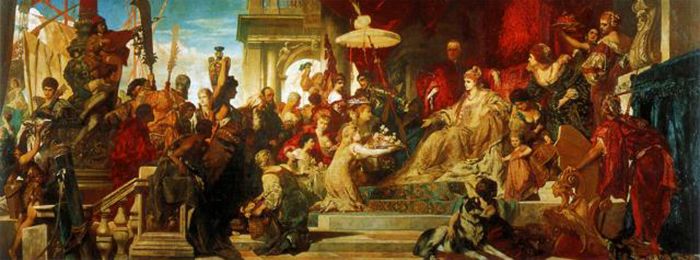
Venice pays tribute to Caterina Cornaro
In this vast tableau a large crowd gathers to pay tribute to a seated and richly-robed Queen who sits towards the right of the picture frame. Clothed in the richly-colored style that recalled the Venetian Renaissance, the crowd carry pots, musical instruments and even weapons. Fabrics drape the backdrop on the right-hand side, but to the left, blue sky, classical architecture and the sails of ships can be seen.
Makart's first history painting, Venice pays tribute to Caterina Cornaro was an unprecedented success; people flocked in their thousands to see it in Vienna before it toured throughout Europe. The grandiloquence of the painting seems rather at odds, however, with its subject matter. Caterina, a fifteenth-century Cypriot Queen, was of minor literal or symbolic importance to the contemporary history painter. But the attraction of the work lies not so much in its subject-matter but rather in its variety and vividness. In her book Hans Makart: Painter of the Senses, Stephanie Auer referred to the painting as "a hymn to life and an act of homage to colour" rather than an earnest veneration of the long-dead monarch. According to Auer, indeed, Makart had succeeded in "transporting the viewer into an ideal world, a fairy-tale past that intentionally lies beyond the bounds of historical reality". Whereas historical painting was typically the vehicle for a contextually significant event and/or message, here the opposite is the case. Markart summoned the past to escape, portal-like, into the textural beauty of marble, fabric and flesh. Some sympathetic contemporary critics called Makart the new Paulo Veronese with one declaring: "Nothing more glorious has been created since the glittering golden age of Italian art".
Oil on canvas - Belvedere Museum, Vienna
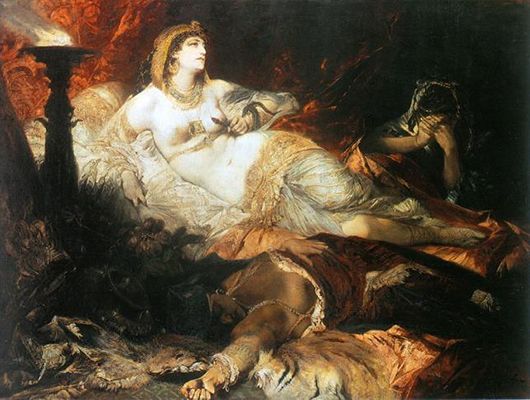
The Death of Cleopatra
In this painting Cleopatra, the legendary queen of Egypt, is shown at the moment just before her suicide. She reclines on a bed of fabrics, semi-nude and wearing jewelry and her crown. To her left, one of her servants weeps, whilst just below the queen another has already passed. A brazier burns on the left-hand side.
Theatrical melodrama pervades Makart's depiction of this famous subject matter; his use of chiaroscuro picks out the stark whiteness of Cleopatra's body, as if she were spot-lit on a stage. In fact, many details seem to have been drawn from Shakespeare's account, such as the presence of the servants, and the detail of the queen's royal attire. The spot-lighting then leaves the other areas of the painting, in which can be found mourning and death, murky and foreboding. In the bottom-left of the frame, meanwhile, the flowers and animal skins seem almost to be rendered in grisaille (flat shades of grey). These great contrasts in lighting culminate in the brazier, whose silhouette is topped by a bright white flame. As a whole, the painting evokes the sense of the queen's preeminence and the moment of her death; a tragic elevation before her fall which seems to engender her far-off, almost longing facial expression.
Another sort of longing is present in the asp, whose thin, black form and tiny wisp of a tongue stand out against her breast; sensitivity, eroticism, and danger combine in the painting which presents, as Shakespeare writes, a death which is "like a lover's pinch, which hurts, and is desired". In the sensuous decadence of Cleopatra's naked, jeweled body Makart seems to echo the Symbolist artist Gustave Moreau, who also painted a version of Cleopatra. However, in comparison to Moreau's implacable, flat figure, Makart bathes his Cleopatra in shadow and in dramatic perspective.
Oil on canvas
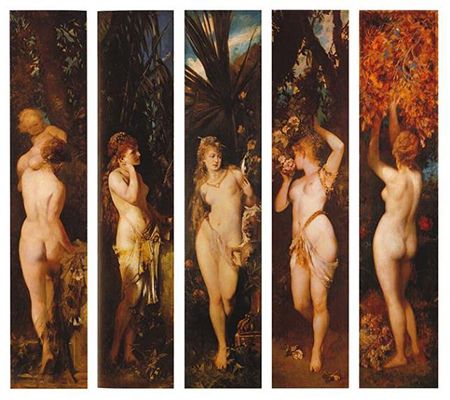
Five Senses
In the Five Senses Makart depicts five female nudes, on five separate canvases, each placed in a forest setting. The women are "rotated" towards a different viewpoint and are engaged respectively (reading from left-to-right) in the activities of touching, hearing, seeing, smelling, and tasting. The prevailing theme is unambiguous however: female eroticism.
"Touching" turns away from the spectator, her legs grasped at by black gauze and funerary white flowers while resting, perhaps, on her shoulder is a cupid-like figure. Covered with pure white drapery, meanwhile, "Hearing" cuts a slightly more chaste, distracted figure as she clasps reed-pipes. "Seeing" is bedecked in many necklaces, a sharp hair-pin, and a jeweled girdle with her lips painted red - material riches that, coupled with her narcissism (as she admires her own gaze in the mirror), resembles the tradition of moralistic vanitas paintings. "Smell's" sensitive underarm and waist are caressed by rich pearls and sashes but Markart tests the boundaries of nude portraiture with the profusion of blossoming flowers which were (and are) a widely recognized symbol of the female genitals. "Tasting", finally, is the only fully nude figure and she, like "Touching", turns away from the spectator, the outline of her curves cut sharply against the dark background. Reaching, like Eve, to grasp a fruit, and her state of total undress, intimates a coming sinful fall. This "Edenic" nudity is very much comparable to the work of Makart's contemporary Hans von Marées. Where Marées experiments with homoeroticism and flat, painterly strokes, however, Makart maintains a more academic naturalism; he maintains a focus more in line with nude convention of fully-rounded soft femininity.
As many art historians and critics have remarked, this series of works essentially presents five different viewpoints of the academic female nude, the type of which might have been practiced for use in history paintings. In Hans Makart: Painter of the Senses, Werner Hoffman writes that the Five Senses "are five ways of experiencing the specifically feminine: we taste it, we absorb its aroma, it enchants our ears and rivets our eyes, it arouses our desire to touch". There is an all-encompassing fullness to the work which might be compared to Makart's expansion of the definition of art more generally, fusing decoration, fine art, and elements of erotic life.
Oil on canvas
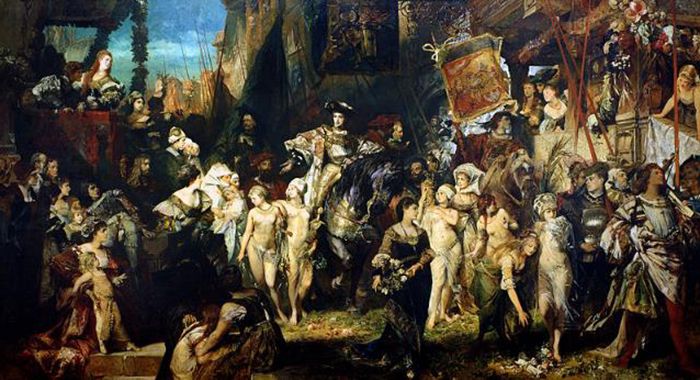
The Entrance of Emperor Charles V into Antwerp
Set in 1520, this work shows the youthful king riding a black horse into the centre of Antwerp, flanked by ornately-dressed subjects and several semi-naked women. They proceed along a street strewn with flowers, with the tops of houses visible above them.
The Entrance of Emperor Charles V into Antwerp was the source of considerable controversy at the time of its first exhibition due to Makart's inclusion of the naked female figures. This was dismissed as both historically inaccurate and somewhat indecorous for a scene which was central to Austria's sense of national identity. Equally shocking was the fact that the faces of the women were uncannily similar to living members of Viennese high society. As Werner Telesko points out in Hans Makart: Painter of the Senses, however, neither historical accuracy nor nationalist sentiment were particularly important for the artist, who prioritized "a contrast between costume drama and nude painting [...] neglecting the historical situation and location".
As with so many of his other works, it is the exquisite layering of different textures that is central to the picture's quality: from the lush fabrics, to the shine of the horse’s plate-armor, to the sheen whiteness of bare female flesh. Indeed, there is such a cascade of figures and finery in the work that it is almost impossible to delineate dimensions or background; the buildings and sky seem to float above the mass of people quite separately, and an ominous black mass rears up to the left of the monarch. Clearly dreamlike fantasies of luxury and power overrule historical accuracy.
Oil on canvas - Hamburger Kunsthall, Hamburg, Germany
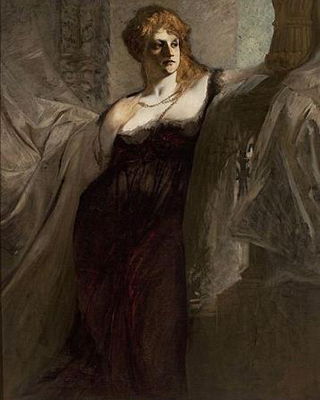
Portrait of a Woman
In this three-quarter length portrait the subject is shown standing, illuminated from the top right. She gazes towards the source of this light, and leans against some architecture which is partially concealed by a gauzy material. Dressed in black, her right hand rests on her shoulder, with her necklace entwined around the fingers.
Although famous for his colossal, multi-figure paintings, Makart also created many female portraits during his lifetime. He continued working on this particular example until the time of his death, and so it may well be unfinished. The portrait departs from Makart's familiar style in a variety of ways: instead of a mass of varied fabrics, two similar shades of the same gauze dominate the painting. Like a shroud, they both conceal and reveal the details of the body and of the architecture against which it leans. The style of this stonework, and indeed of the painting as a whole, is rather gothic; whilst the partial-concealment is erotic, it is also mysterious and not altogether comforting. The same extreme paleness in his other female figures is also present here, but it is interrupted by the strong shadow which cuts across the woman's face. This, along with the uncharacteristically commanding expression, might well be compared to a mythical figure of dangerous and powerful femininity, such as Clytemnestra or Medea. The haziness continues into the background in the top of the painting, which is misty and as undefined as is every other element of the work. This might be thought of as one of Makart's most "Symbolist" paintings, where his usual bright sensuality is transfigured into something much more brooding.
Oil on canvas - National Museum, Warsaw, Poland
Biography of Hans Makart
Childhood
"Hans" Johann Evangelist Ferdinand Apolinaris Makart was born to Johann Makart and Maria Katharina Rüssemayr in Salzburg in 1840. His father, a failed painter, worked as the chamberlain of the Mirabell Palace, the home of the powerful Prince-Archbishop. Little is known about Makart's early years, but it is likely that he grew up around the Neoclassical splendor of this pleasure-palace and its extensive Baroque gardens. It seems likely that his grandiose surroundings left a lasting impression on an artist who would later indulge in surfeits of luxury and ornament, not only in his painting, but also in his work as a designer and decorator. His father may also have encouraged his son to take up painting, to succeed where he had failed, but his father died in Italy in 1849 shortly before Hans reached his tenth birthday.
Early Training and Work
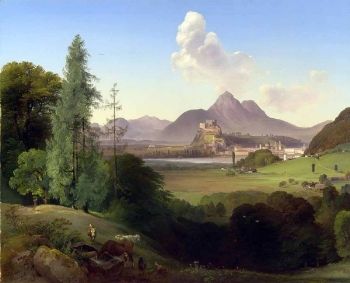
In 1850, Makart, aged just eleven years old, moved to Vienna to study painting under Johan Fischbach at the Academy of Fine Arts. It seems that he took issue with precise structure and order of the Academy, both in terms of pedagogy and in the type of artwork it revered, and he was dismissed from the institution after only a year. Although the given grounds for his dismissal were a lack of natural talent, it is hardly surprising that Makart's early penchant for intense color, movement, and sensuality - reminiscent of the style of Titian or Rubens - would clash with the austere, controlled classicism that still dominated academic art at the time. It was not until his move to Munich ten years later that his own, distinctive style began to develop. Seemingly impervious to criticism, Markart's decadent lifestyle also came to define him as a rebellious talent.
Following a two-year period of self-instruction, Makart enrolled in the Munich Academy where he was tutored by the realist painter Karl von Piloty. His first painting of note, Lavoisier in Prison (1861), was produced under Piloty's tutorage, and though considered somewhat tentative and conventional overall, attracted attention for its bold and original use of color. During this early period during which he honed his highly decorative style, Makart also travelled to London, Paris and Rome. While in the Italian capital, the artist was invited to submit a piece for the opening of the Austria Artists' Society in Vienna in 1868. Makart sent over his colossal three-part work Modern Cupids, along with painstaking instructions on how it should be displayed. All three canvasses were bought by the Count Johann Palffy, who became a regular patron of the artist. Appearing to suit the tastes of the nobility rather well, Makart also attracted the attention of the Austrian Emperor Franz Joseph, who bought his Romeo and Juliet for the Vienna Museum before summoning the artist himself to work and live in Vienna in 1869. In the same year, Makart married Amalie Franziska Roithmayr, though she died only four years into their marriage.
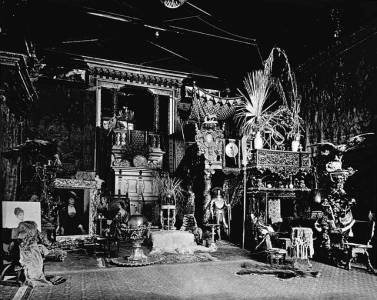
Although it is thought that Makart requested a set of lavish apartments from the Emperor (which would certainly have aligned with his reputation for self-confidence and taste for opulence) he was given a studio converted from a disused foundry. Not to be discouraged, Makart transfigured this industrial space into the plush, decadent heart of Viennese society. Known as the "Ring-Road Period" because of the fashionable boulevard created around the city, the Belle Époque in Vienna was a time of cultural and artistic celebration. During the early-to-mid 1870s, the bourgeois and nobility alike congregated in Makart's studio-turned-salon, with the artist serving as high-priest to an aestheticism of art and living. Having turned his hand to interior design, costume design, furniture design and soft-decoration, his studio overflowed with statues, flowers, fine fabrics, and music. It acted thus as the perfect artistic backdrop for his models - largely nude women - who were also welcomed into his high-society circle.
Mature Period
It is problematic to talk of Makart's "mature" and "late" periods given that he died at such an early age (forty-four). Nevertheless, with his reputation growing exponentially throughout the 1870s, Makart standing in his later life was such that the so-called Makartstil, or Makart-Style, came to define cultural life in Vienna and the period of "Ring-Road" Aestheticism. From hats to very particular shades of red, Makart's name lent any item or trend a superlative élan. It is true that elements of French Symbolism and Aestheticism are omnipresent in his style, but instead of darkness and morbidity, Makart's work focused much more intensely on vivid color, decoration, and unabashed sensuality. In this respect, he sits much closer to the Art Nouveau movement that would become popular towards the end of the century, and upon which he had a significant influence. One might also observe the influence of Orientalism on his work which most observers have attributed to Makart's travels throughout Europe and North Africa during the 1870s.
Late Period
In 1878 Makart accepted a position at the very institution that had expelled him and condemned his talents when he became a professor at the Viennese Academy. Only two years later, he was appointed head of a specific school for history painting within the institution, a role he occupied until his death in 1884. It was during this time that Makart crossed paths with a starstruck student named Gustav Klimt. It was Klimt in fact who did most to take Makart's legacy forward following his death. In addition to his professorship, Makart's works continued to provide him with wealth and recognition. Even criticisms seemed only to fuel his achievements. This was the case with his 1878 painting The Entry of Charles V into Antwerp which was condemned for its depiction of female nudity set in an early-modern scene. The painting was in fact banned in America which naturally increased the desire amongst the American public to see this work, and, by default, other such works by him.
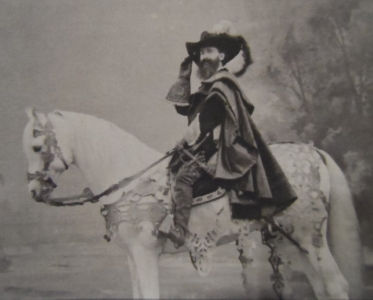
In 1879 the Emperor commissioned Makart to organize and design a pageant for his silver wedding anniversary. The artist did not disappoint. Dressing citizens up in Renaissance outfits, and having a float of artists in Baroque costume, he himself rode near the front of the parade on a white horse. Makart seemed to conjure up a different age for the Viennese, creating a magnificent event so popular that it continued annually up until the 1960s. Makart's royal patronage did not stop there either. The Emperor once again called on the artist to design the decor of the Villa Hermes for his wife, asking him to recreate the scene of Shakespeare's A Midsummer Night's Dream. The plan, however, was never carried out, and the artist died of syphilitic meningitis in 1884. The 1,083 works of art that he owned were put up for auction after his death, and his magnificent studio was left to fall into disrepair.
The Legacy of Hans Makart
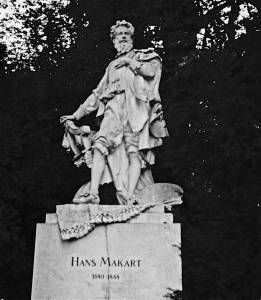
Though remembered by many as the "magician of colors" (including the failed artist Adolph Hitler who is said to have been an admirer), following his death Makart suffered a serious decline in reputation. With him died the specific pocket of culture and celebrity life which had revolved around him and his coterie for some twenty years. Despite this, his influence on design and decoration continued strongly. Several commemorative stamps and currency prints have been dedicated to him, and within his hometown of Salzburg can be found a square which bears his name. But most significant, perhaps, was his influence on Gustav Klimt and of the Vienna Secession. Whereas Makart began as an outcast, and only then joined the establishment in the form of the Academy, Klimt's artistic journey followed the inverse route: idolizing his professor's artistic principles and academic pedagogy, Klimt eventually developed his own, more abstract, language, but one that maintained a recognizable "Makartstil" in its focus on female sensuality and sumptuous decoration.
Unfortunately history has shown that Makart was in the habit of using sub-standard bitumen pigments that mean that many of his works have deteriorated: blues have turned to green for instance and the rich glow of his colour harmonies and the thickly applied paint have often deteriorated and/or cracked and crumbled over time. Nevertheless, important examples of his work survive in galleries in Vienna, Berlin, Hamburg and Stuttgart. In the Vienna Museum one can also find a series of fine decorative lunettes executed by Makart's hand.
Influences and Connections

-
![Arnold Bocklin]() Arnold Bocklin
Arnold Bocklin - Viktor Tilgner
- Anselm Feuerbach
-
![Symbolism]() Symbolism
Symbolism -
![Orientalism]() Orientalism
Orientalism - Academic Art
-
![Arnold Bocklin]() Arnold Bocklin
Arnold Bocklin - Anselm Feuerbach
-
![Art Nouveau]() Art Nouveau
Art Nouveau - Secessionism
